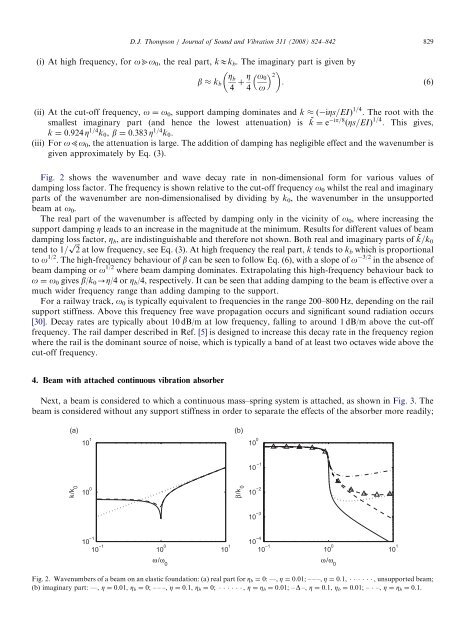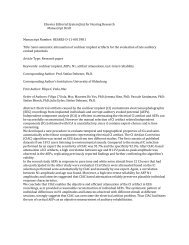A continuous damped vibration absorber to reduce broad-band ...
A continuous damped vibration absorber to reduce broad-band ...
A continuous damped vibration absorber to reduce broad-band ...
Create successful ePaper yourself
Turn your PDF publications into a flip-book with our unique Google optimized e-Paper software.
(i) At high frequency, for obo0, the real part, kEkb. The imaginary part is given by<br />
b kb<br />
Zb Z<br />
þ<br />
4 4<br />
o0<br />
o<br />
2<br />
. (6)<br />
(ii) At the cut-off frequency, o ¼ o0, support damping dominates and k ð iZs=EIÞ 1=4 . The root with the<br />
smallest imaginary part (and hence the lowest attenuation) is ~ k ¼ e ip=8 ðZs=EIÞ 1=4 . This gives,<br />
k ¼ 0:924 Z 1=4 k0, b ¼ 0:383 Z 1=4 k0.<br />
(iii) For o5o 0, the attenuation is large. The addition of damping has negligible effect and the wavenumber is<br />
given approximately by Eq. (3).<br />
Fig. 2 shows the wavenumber and wave decay rate in non-dimensional form for various values of<br />
damping loss fac<strong>to</strong>r. The frequency is shown relative <strong>to</strong> the cut-off frequency o0 whilst the real and imaginary<br />
parts of the wavenumber are non-dimensionalised by dividing by k0, the wavenumber in the unsupported<br />
beam at o0.<br />
The real part of the wavenumber is affected by damping only in the vicinity of o0, where increasing the<br />
support damping Z leads <strong>to</strong> an increase in the magnitude at the minimum. Results for different values of beam<br />
damping loss fac<strong>to</strong>r, Zb, are indistinguishable and therefore not shown. Both real and imaginary parts of ~ k=k0<br />
tend <strong>to</strong> 1= ffiffiffi p<br />
2 at low frequency, see Eq. (3). At high frequency the real part, k tends <strong>to</strong> kb which is proportional<br />
<strong>to</strong> o 1/2 . The high-frequency behaviour of b can be seen <strong>to</strong> follow Eq. (6), with a slope of o 3/2 in the absence of<br />
beam damping or o 1/2 where beam damping dominates. Extrapolating this high-frequency behaviour back <strong>to</strong><br />
o ¼ o0 gives b/k0-Z/4 or Zb/4, respectively. It can be seen that adding damping <strong>to</strong> the beam is effective over a<br />
much wider frequency range than adding damping <strong>to</strong> the support.<br />
For a railway track, o0 is typically equivalent <strong>to</strong> frequencies in the range 200–800 Hz, depending on the rail<br />
support stiffness. Above this frequency free wave propagation occurs and significant sound radiation occurs<br />
[30]. Decay rates are typically about 10 dB/m at low frequency, falling <strong>to</strong> around 1 dB/m above the cut-off<br />
frequency. The rail damper described in Ref. [5] is designed <strong>to</strong> increase this decay rate in the frequency region<br />
where the rail is the dominant source of noise, which is typically a <strong>band</strong> of at least two octaves wide above the<br />
cut-off frequency.<br />
4. Beam with attached <strong>continuous</strong> <strong>vibration</strong> <strong>absorber</strong><br />
ARTICLE IN PRESS<br />
Next, a beam is considered <strong>to</strong> which a <strong>continuous</strong> mass–spring system is attached, as shown in Fig. 3. The<br />
beam is considered without any support stiffness in order <strong>to</strong> separate the effects of the <strong>absorber</strong> more readily;<br />
k/k 0<br />
10 1<br />
10 0<br />
10 10 0<br />
10<br />
D.J. Thompson / Journal of Sound and Vibration 311 (2008) 824–842 829<br />
ω/ω 0<br />
10 1<br />
10 0<br />
10<br />
10<br />
10<br />
10 10 0<br />
10<br />
Fig. 2. Wavenumbers of a beam on an elastic foundation: (a) real part for Zb ¼ 0: —, Z ¼ 0.01; – – –, Z ¼ 0.1, , unsupported beam;<br />
(b) imaginary part: —, Z ¼ 0.01, Zb ¼ 0; – – –, Z ¼ 0.1, Zb ¼ 0; , Z ¼ Zb ¼ 0.01; – D –, Z ¼ 0.1, Zb ¼ 0.01; – –, Z ¼ Zb ¼ 0.1.<br />
β/k 0<br />
ω/ω 0<br />
10 1
















